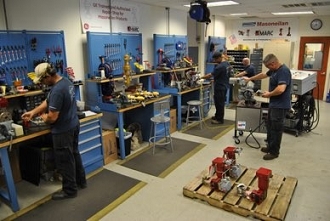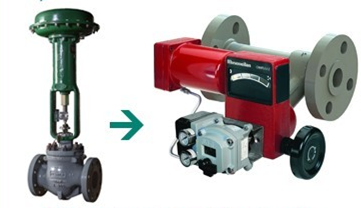The Ultimate Question for Control Valve Maintenance: Repair Or Replace?
The impact of a facility’s decision to repair control valves, versus replacing them, in the coming months could result in more effort, time and money than expected.
#maintenance-repair
Facilities typically schedule outages, turnarounds or shutdowns to repair or replace equipment like control valves. They coordinate these scheduled shutdowns to allow for preventative maintenance (PM). During this time, the facility removes the control valves to allow for the inspection and evaluation of potential damage or issues.
The PM may require certain control valves to be evaluated for repair at certain frequencies (annually, bi-annually, etc.), whether there are any known issues or not. In addition, any identified "troublesome" valves, will be pulled for evaluation. The time frame for being shut down can range from days to weeks or a month. It is vital, from a profitability aspect, to have the process go smoothly and everything be up and running on time.
PROCESS OF PLANNING A SHUTDOWN FOR CONTROL VALVE REPAIR
- Determine in advance (3-6 months prior) which control valves need to be evaluated.
- Walk the facility and identify serial numbers of control valves for proper specifications.
- Submit Requests for Quotes to vendor(s) for estimated cost of repair.
- Schedule workforce needed for removal and installation of control valves.
- For example, welded valves would require skilled labor and proper equipment/tools for the job.
- Schedule the sequence of the work, as well as any special work permits.
- Schedule proper equipment such as cranes, scaffolding, lifts, hoists, etc.
- Schedule outage planning meetings with site personnel, contractors and subcontractors.
- Decontaminate the control valves prior to sending out for repair.
- Package and place valves on pallets and coordinate logistics for send/return.
The potential for risk is great during the process of repairing control valves. Risks may include:
- Wrong parts ordered
- Parts lost on-site
- Parts not delivered on time
- Required repair costs more than the estimate
- Valve unable to be repaired once opened up for inspection
- Delays on a replacement valve that is needed
Once "non-essential" and "essential" businesses, as classified by the COVID-19 crisis, return to full production, there could be additional risks, such as backlogs on parts and service from manufacturers. Because of the increase in demand, there could be a shortage of skilled labor available to do this work. This will cause delays and possibly even safety risks if "unskilled" labor is used to get the work done. All of these risks can significantly impact the cost of the repair.
HYPOTHETICAL REPAIR COST SCENARIO
Let us look at a hypothetical valve repair. Assume there are 40 control valves requiring repair at an estimated $2,500 per valve. This results in a $100,000 repair quote. The valves will be returned to the facility after being repaired, in partial shipments with a three week promised delivery date. The alternative was to replace all 40 control valves at a known cost of $200,000. The facility decides to save half the cost of buying all new control valves by repairing all of them. This 50% thumb-rule is quite commonly used to determine if a repair or replacement is required. If the cost of repair is less than 50% of replacement cost, the decision might be made to go with repairing the valves. However, the reality is that once the control valves are inspected, the discovery work (additional repairs/parts needed) typically can add an additional 40% to the initial quote. Let's assume a three-day delay; this will cost the facility in overtime paid and production loss. So if we only add a 10% increase to the initial quote due to the delay, the numbers are now 50% more cost which equates to $150,000 versus the initial $100,000 to repair the valves.
So now the hard questions: "Did we really save money?", "Did we start up on time?" and "What was the cost of our lost production?" are being analyzed by the facility. Note that there could be even greater costs due to delays and other factors, again due to the current COVID-19 situation, as previously mentioned.
REPAIR BY REPLACE SCENARIO
The advantages of repair by replace are many, given that the real cost may not be that much more than repairing the valves.
- Streamlined planning: dealing with one vendor to acquire new control valves, eliminating unexpected repair costs or delays, such as missing spare parts.
- Cost control: by knowing up front exactly what the valve cost and delivery will be.
- Mitigating safety risks: Fewer contractors on-site minimizes exposure to safety risks. Using certified service technicians—highly skilled labor—reduces the risk of improper assembly and installation.
- Reduced labor: The amount of labor to remove the old valves, send off to repair and re-install the valves is cut in half. Labor to package and place valves on pallets is 100% eliminated. Not having to remove valves, wait weeks for them to be repaired and schedule return of manpower to install valves saves significant time, effort and money.
- Reduced cost and effort for equipment: The need for machinery coordinating and use could be cut in half.
- Less shipping: Logistics cost could be cut in half.
Another added benefit could be the ability to upgrade valves’ positioners to smart digital positioners. This kind of positioner provides diagnostic capabilities that enable predicting maintenance needs. This eliminates the guesswork in determining which control valves to evaluate, saving time, effort and cost.
Another benefit of “repair by replace” would be the option of upgrading to low-emissions packing to reduce fugitive emissions to the surrounding environment.
Yet another advantage might be to replace valves with different types that still do the job. For example, a reciprocating globe valve could have a drop-in replacement that is a rotary control valve (Figure 3). The replacement valve would offer smaller size, half the weight, lower cost, fewer leakage paths and a smaller number of spare parts.
There are many benefits to repair by replace. This scenario eliminates a significant amount of time, effort and cost that would not be obvious from just looking at the quote for repairing the valves. In addition, the facility will have added value by upgrading the control valves and has the reassurance of a warrantied new control valve to ensure the facilities critical process control is well maintained for years to come. On top of that, this approach means no unplanned downtime and resulting loss of production.
PARTNERING WITH A MANUFACTURERS REPRESENTATIVE
This whole process can be made easier by partnering with control valve experts, such as manufacturers reps. Many stock a comprehensive inventory of control valves, positioners and actuator types and are able to provide the needed configurations. In addition, some offer services to support facility PM shutdowns, including surveying existing valves to determine which need replacement, and repair and/or installation.
SUMMARY
During normal times, the cost of repair versus replacement may initially look inviting and seem reasonable. However, during the COVID-19 crisis these are not normal times. Even under ideal conditions, the actual cost of repair frequently exceeds the original estimate and repair always requires the valve be shipped to the repair company. Add to this the complications caused by the pandemic, such as shipping delays and backordered spares, and replacement may be preferable. To make the right decision, pay careful attention to all the factors involved, not just the repair itself. In many cases, the decision to "repair by replace" can significantly reduce a facility’s time, effort and costs, especially during the current uncertain business climate.
Jason Ordanoff is business development manager with Eastern Controls Inc. and has over a decade of experience providing control valve solutions to customers in all industries.
RELATED CONTENT
-
Actuator Issues? Use This Checklist!
While there may be 40 reasons valve actuators may stop working, there really is only a handful of components that can cause the problems. So, if you have an actuator on the fritz, here are the five things you need to check.
-
Ball Valve Repair 101
From time to time, we are re-posting well-received or particularly valuable articles that have previously run on VALVEMagazine.com so that those who might have missed them will be able to catch up on the best of the best.
-
Understanding and Selecting Valve Flanges, Pt. I: Design and Standards
Because flanges allow the assembly and maintenance of system components without the need for cutting and welding pipe, they play an important role in piping systems.













 Unloading large gate valve.jpg;maxWidth=214)